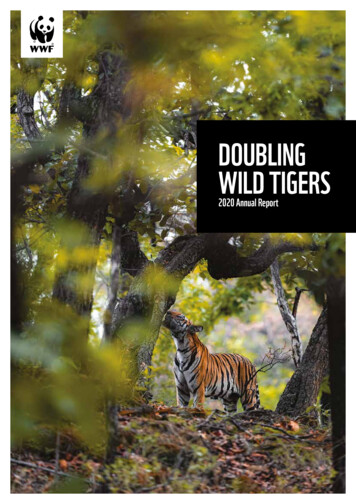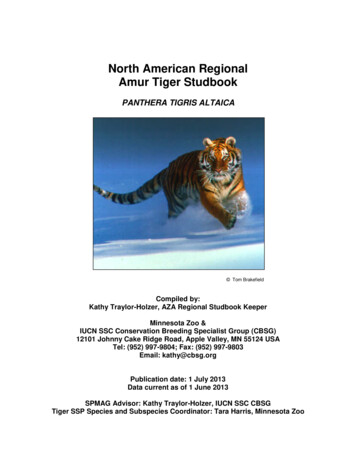
Transcription
DOUBLINGWILD TIGERS2020 Annual Report
CONTENTSPrepared by WWF Tigers Alive and designed by Kazi StudiosFOREWORD1MAJOR MOMENTS OF 20204WHERE WE WORK6HOW WE WORK8ADAPTING TO CRISIS10AVOIDING EXTINCTION16Feature story: The snaring crisis inSoutheast Asia29Feature story: Meet the all-femaleranger team protecting China's tigers35LIVING WITH TIGERSPublished in March 2021 by WWF. Any reproduction in full or in part must mentionthe title and credit the above-mentioned publisher as the copyright owner. Text 2020 WWFCover Photo Suyash Keshari / WWF-InternationalFeature story: How Pilibhit Tiger Reservemore than doubled its tiger populationBRINGING BACK THE ROARFeature story: Bringing tigers back toIndia's Western Terai Arc Landscape Emmanuel Rondeau / WWF-USWWF TIGERS ALIVE ANNUAL REPORT 202041495357THE PATH TO 202261THANK YOU65
A GLOBALMISSIONTO SECURE THE FUTUREOF THE WORLD’S MOSTTHREATENED BIG CAT. Ajay Varma / WWF-InternationalWWF TIGERS ALIVE ANNUAL REPORT 20201
2020 THREW A SPOTLIGHT ON OURFRAGILE RELATIONSHIP WITH NATURE.BUT DESPITE ITS CHALLENGES, 2020REAFFIRMED THAT PERSISTENTCONSERVATION CAN HELP SECURE AFUTURE FOR TIGERS.REDUCED TO JUST 5% OF THEIR RANGE,THE YEAR OF THE TIGER WILL BE ANOPPORTUNITY TO REDOUBLE EFFORTSAND SECURE A FUTURE FOR WILDTIGERS.NOW IS THE TIME TOSTEP UP.WWF’S TIGERSALIVE INITIATIVELOOKING BACK AT 2020As we approach the Year of the Tigerin 2022 and the goal to double wildtigers, known as TX2, we are seeing theculmination of long term conservationinterventions leading to someextraordinary results.It has often been said that TX2represents one of the most ambitiousconservation targets ever set fora single species. So it figures thatprogress towards achieving thistarget must represent one of the mostambitious programs ever delivered fora single species.November 2020 marked the 10thanniversary of the 2010 Tiger Summitand WWF, together with partners,launched the inaugural TX2 Awardsto recognise sites that have achievedconservation excellence. India's PilibhitTiger Reserve won the TX2 Award fordoubling its tiger populations over thelast decade, estimated to be 65 tigers asof 2018. The winner of a further awardfor ‘Conservation Excellence’ was thetransboundary partnership created in2011 between Bhutan and India - theTransboundary Manas ConservationArea. Data from the last survey in 2018estimates tigers in both sites to havemore than doubled since 2010.These successes prove it is possible forlarge carnivores to survive in humandominated landscapes, provided safehavens and human-tiger interactionsare managed. But in some countries theroad to tiger recovery remains fraughtwith challenges.One of the root causes of the extinctionwave that is sweeping across much ofSoutheast Asia was revealed in a WWFreport, Silence of the Snares: SoutheastAsia’s Snaring Crisis. The report is astark reminder of how a simple butWWF TIGERS ALIVE ANNUAL REPORT 2020deadly contraption can eradicate bothwildlife and hard-earned conservationgains in the absence of rangers andsupportive legislation.WWF-Malaysia’s Project Stampedecontinues to demonstrate theeffectiveness of conservation whenworking in partnership with indigenouspeoples. The data from their dedicatedsnare removal patrols shows massivelyreduced levels of snaring in RoyalBelum State Park. New legislation wasalso introduced in Russia, prohibitingthe use of snares in any areas occupiedby tigers, snow leopards and Amurleopards.Global Tiger Day 2020 was markedwith the announcement of India’sadoption of the Conservation Assured Tiger Standards (CA TS) across all ofthe country’s 50 Tiger Reserves, whichcover 65% of its wild tigers. WWFIndia is now partnering with the GlobalTiger Forum to implement CA TS in allTiger Reserves.Tigers are also on the move asevidenced by the record for the highestaltitude tiger in Nepal being brokentwice in a year. Early in 2020 a tigerwas recorded in the far west of Nepalat 2500m, which was surpassed inNovember with a tiger recorded at3165m in the far east of the country.At the heart of this range expansionare core protected areas, connected bycorridors and the presence of adequateprey species in the wider landscape.Sometimes, tigers need a helping handto recolonise their former range. Aftermore than a decade of planning byWWF-India and partners, tigers havebeen released in the western part ofthe Rajaji Tiger Reserve in December2020. Progress to reintroduce tigers Ola Jennersten / WWF-Swedento Kazakhstan is also on track with thereturn of the tiger set for 2024!2022 will representboth the lunar Year ofthe Tiger and a GlobalTiger Summit - a oncein 12-year opportunityto measure progresstowards TX2 and set newand ambitious goals.There is no doubt that the global trendfor tiger numbers is on the rise. Butwill TX2 be realised? There will be anumber of new estimates from tigerrange states released during next yearthat will piece together the story oftiger numbers.Beyond 2022, and looking into the next12 year cycle, what does the future holdfor the species? Tigers are found in lessthan 5% of their historic range. What ifTX2 could be reimagined to representa doubling of tiger range by 2034?Expanding tiger range both within andoutside existing range and bending thecurve with the recolonisation of tigersin places where the conditions for tigerrecovery can be recreated.This is an exciting prospect, and wecan’t wait for you to join us on thejourney to 2022, the Year of the Tiger!Stuart ChapmanLeader of WWF’s Tigers Alive Initiative3
RUSSIATIGERS CONTINUE TO RECOVER INRUSSIAN FAR EAST PROVINCEFIRST COVID-19 CASERECORDED OUTSIDE OF CHINAThailand was the first countryto confirm COVID-19 outsideChina.WWF-Russia and the Amur TigerCentre estimated a populationof 20 tigers within EvreiskayaProvince, including the Heartlandsite of Pompeerski NationalPark. Since 2013 WWF has beensupporting translocations of tigersin Evreiskaya, an area that had notigers when the project started.JANUARYFEBRUARYCOVID-19 GLOBAL PANDEMICDECLAREDOn the 11th March the WorldHealth Organisation officiallydeclared the COVID-19outbreak a global pandemic.A large number of countriesentered national lockdownsduring March, closing theirborders and put heavyrestrictions preventing themovement of people.NEPALRECORDS ARE BROKEN!Camera trap imagesreveal the highest altitudesighting of a tiger in Nepal,captured at over 2500m.This evidence of a tigersupports the notion thathigh altitude habitats mayprovide refuge for tigersand help connect theirterritory between Nepaland India.APRILMARCHNEPALINCREASING PRESSURES ONPROTECTED AREASIMPACTS OF TRAVEL BANS HITECO-TOURISMHomestay owners and tourismoperators are severely impactedby COVID-19 lockdowns and thehalt to travel across the globe.This places financial stress oncommunities and increasespressures on protected areas.For example, India's CorbettTiger Reserve receives anestimated US1,00,000 in parkentrance fees annually.Data from 11 protected areasin Nepal found that humanentry into protected parks rosesignificantly during the nationallockdown due to COVID-19. Thefirst month of the lockdown (24March – 24 April) saw morecases of illegal extraction offorest resources such as illicitlogging and harvesting than thepreceding 11 months combined.MAYJUNEA SNAPSHOT OF 2020JULYA WWF report warns of a snaring crisisthreatening wildlife in the protected areasof Cambodia, Lao PDR, and Viet Nam.Snaring threatens tigers and tiger prey.One of Southeast Asia’s most importantremaining tiger landscapes, BelumTemengor in Malaysia, experienced a50% decline in tiger numbers from 20092018 largely due to snaring.SEPTEMBERMYANMARWILDLIFE MONITORING UNIT TRAINEDWith the support of WWF-Myanmar,29 community members were trainedas part of a Wildlife Monitoring Unitand has begun occupancy surveys inremote areas of the Dawna TenasserimLandscape.OCTOBERMALAYSIATIGER SIGHTING BRINGS HOPEA tigress and three cubs werecaptured on camera traps inMalaysia earlier this year.With the ongoing poachingcrisis still plaguing many ofthe world’s wild tigers, thisdiscovery offers a message ofhope for Malaysia's tigers.WWF TIGERS ALIVE ANNUAL REPORT 2020KENZO PARTNERS WITH WWFFrench fashion house KENZOinaugurates a new capsulecollection, in support oftiger conservation. Thiscollaboration forms part of abroader partnership betweenKENZO and WWF.NOVEMBERBHUTAN & INDIATX2 AWARD CELEBRATESSUCCESSIndia’s Pilibhit TigerReserve, Manas TigerReserve and Bhutan’sRoyal Manas National Parkreceived the inaugural TX2Award and ConservationExcellence Award for theiroutstanding contributionto tiger conservation.SOUTHEAST ASIASNARING: SOUNDING THE ALARMINDIAGOVERNMENT EXPANDS CA TSThe announcement by the NationalTiger Conservation Authority ofIndia’s adoption of the CA TS acrossall of the country’s 50 Tiger Reservesis a significant step forward. These 50Tiger Reserves and are home to 65%of India's wild tiger population.BHUTANTIGER RECOVERYDuring 2020 Bhutan recorded sixpreviously unrecorded tigers acrossJomotshangkha Wildlife Sanctuary,Phibsoo Wildlife Sanctuary and SarpangForest Division. WWF-Bhutan hasextended its support to areas outsideof Protected Areas and these sightingshighlight the amazing tale of tigerrecovery that has been unfolding inBhutan since 2010.THAILANDTHAILAND'S TIGER ESTIMATEThailand's Department of NationalParks releases an updated tigerpopulation estimate for Thailand ofbetween 130 and 160 tigers acrossthe country.DECEMBERCHINATRIALLING NEW TECHNOLOGYA real-time surveillance systemis piloted to monitor tigers,prey, and human disturbancein Huangnihe National NatureReserve. In the first month ofdeployment, one case of forestresources being illegally extractedand the presence of one tigerwas recorded. The images wereimmediately transferred to theauthorities to be reviewed.NEPALRECORDS ARE BROKEN AGAIN!A new tiger sighting at 3165mmarks the highest altitudinalpresence of tigers in Nepal andis 250km away from Nepal’spreviously known eastern limitfor tigers. The sighting of the tigerin Ilam points to existing habitatlinkages between Nepal and India.USABIG STEP FORWARD FOR CAPTIVETIGERS IN USAThe US House of Representativespassed the Big Cat Public Safety Act.This legislation will help preventcaptive tigers from ending up inthe illegal trade in tiger parts andproducts, the primary threat to thespecies in the wild. WWF's TigersAlive Initiative will work to ensure itspassage in both the House and Senate.INDIATIGER TRANSLOCATION STARTSA wild tigress was translocatedfrom the Corbett Tiger Reserve toRajaji Tiger Reserve in an effortto repopulate tigers in the area.This was done by a joint team ofthe National Tiger ConservationAuthority, Uttarakhand ForestDepartment and WWF-India.5
Shutterstock / WWF-InternationalFrom the boreal forests in the Amur HeilongEco Region where temperatures can reach-40 C to the tropical forests of the DawnaTenasserim Landscape, tigers inhabit adiverse range of landscapes.WWF’s tiger conservation is carried out across 14 keylandscapes and within these landscapes are 50 tigerHeartlands which have been identified as having thehighest potential for tiger recovery. WWF is working tosecure these critical habitats and to also restore sites inHistoric Tiger RangeCurrent Tiger RangeWWF Tiger LandscapeWHEREWE WORKReintroduction SiteWWF TIGERS ALIVE ANNUAL REPORT 2020Kazakhstan and Cambodia so that tigers can be returnedto part of their historic range.As well as harbouring the entire global wild tigerpopulation, the majority of the world’s people live inAsia. Tiger landscapes spread across forests, grasslands,shrubland and mangrove swamps and provide invaluableecosystem services to billions of people. This highpopulation pressure presents one of the greatest threatsto tigers, but with it a unique opportunity to demonstratethat co-existence with large carnivores is possible.Freedom to moveMore than half of WWF supported tiger landscapesstraddle international borders, and facilitatingcooperation between tiger range countries is a crucialcomponent of the global goal to double wild tigers.7
When the world decided to doublewild tigers in 2010, a major part ofWWF’s commitment was to set upthe Tigers Alive Initiative to workwith Tiger Range Countries to driveforward the TX2 goal.HOW WEWORKWWF has three goals to help secure a future for tigers.Each requires a bold vision, exceptional leadership,and commitment from governments, communities, andconservation investors.BETTER TOGETHERAvoiding extinction: protecting,connecting and restoring critical tigerlandscapes, as well as stopping the tradeand reducing demand for tiger products.Living with tigers: managing conflictswith tigers, and strengthening public,private and community support for tigerconservation.Bringing back the roar: planning forreintroductions and expanding the tiger’srange.In each of our 14 priority landscapes WWF partners withgovernments, local communities and grassroots organisationsto benefit tigers, people and ecosystems. We work withtechnical partners to deliver critical protection tools such asSpatial Monitoring and Reporting Tool (SMART) to informand help improve anti-poaching patrols.Likewise, the implementation of tiger specific protected areamanagement standards (CA TS), as well as our approachto reducing poaching through the Zero Poaching Toolkitand efforts to reducing trade would not have been possiblewithout collaboration with our partners.AN INNOVATIVE APPROACHDespite the challenges created by the COVID-19 pandemicin the last year tiger conservation has continued. WWFcontinues to facilitate and support innovative interventionsacross tiger range countries, such as patrol prediction andinfrastructure forecasting using artificial intelligence, eDNAtesting for biodiversity monitoring, and a new SMARTfunctionality that can help in understanding the poachingnetwork in an area.Throughout this report you’ll read more about our innovativeapproaches to securing a future for tigers and how we’veadapted to creating positive impact amid the COVID-19pandemic. Emmanuel Rondeau / WWF-USWWF TIGERS ALIVE ANNUAL REPORT 2020Venturing out: Between 17 and 24 monthsof age, tiger cubs leave their mother’s side insearch of their own territory.9
ADAPTINGTO CRISISCopyright WorrapanCreditPhumanee Copyright/ WWF-Thailandowner / WWF-WWF TIGERS ALIVE ANNUAL REPORT 2020Global Tiger Day 2020, Thailand11
ADAPTING TO THE GLOBAL PANDEMICFamilies and communities suffering, daily lifedisrupted, and businesses failing. Many staff andWWF partners have not escaped these impacts, andvulnerable communities have felt them even moreacutely.This has also presented a number of uniquechallenges to tiger conservation.Beyond the day-to-day challenges common to mostorganisations, the COVID-19 pandemic forced us toevolve and constantly adapt. Priorities and fundingacross NGOs, governments and local partners shiftedin response to the immediate impacts of the pandemicand travel restrictions prevented staff from meetingfor training or conducting field work, and reducedinteraction with local communities.Restriction on movement has not always impactedprotected areas in predictable ways. In Nepal, theserestrictions brought increased illegal entries intoprotected areas, while in other tiger range countriessuch as China, poaching pressures sharply decreased.Ecotourism has been one sector severely impactedby the enforcement of lockdowns across theglobe, especially impacting tiger landscapes andcommunities in Nepal, Bhutan and India. Thedecline in tourism revenues poses a direct threat tothe livelihoods of community rangers, park revenueand income streams for local communities. Nepal’stourism industry for instance generates 95% of parkrevenue, 30-50% of which is channeled back into thedevelopment of local buffer zone communities by law.COLLABORATION WITH COMMUNITIES ISMORE CRITICAL THAN EVER.WWF provided emergency relief to communitiesin some tiger landscapes with food parcels andhygiene equipment and continues to support thesecommunities and local organisations to help themrecover and build resilience to future threats. WWFIndia contributed over US 150,000 in immediatemeasures to support approximately 15,000households across their tiger landscapes.WWF will work with partners to increase theresilience of community-led conservation, includingdiversifying income opportunities, developing moreresilient tourism, strengthening legal frameworks, andworking with communities to co-create sustainablelivelihood development solutions. Karine Aigner / WWF-USWWF TIGERS ALIVE ANNUAL REPORT 2020Bika Ram Gurau, and Rupani Devi Gurau sit on theporch of the family home in the Amaltari / BagkurVillage of Nepal. The homestay pictured in thebackground is owned by their son.13
CALLING FOR INCREASED INVESTMENT INRANGERS AND PROTECTED AREASSUPPORTING RESILIENT COMMUNITIES INMYANMAR’S DAWNA TENASSERIM LANDSCAPEA survey of people charged with managing 40 protected areasin tiger range countries, released in June 2020, revealed thathalf of respondents claimed funding has been reduced sincethe global pandemic began. The survey, led by WWF’s TigersAlive Initiative in collaboration with Ranger Federationof Asia and CA TS, also showed that the ability of rangersto effectively work has been compromised by additionalresponsibilities, salary cuts and disruption of essentialsupplies and equipment.WWF-Myanmar provided support to the Dawei Civil SocietyOrganisation's COVID-19 Committee which was set tomitigate the spread of COVID-19 in the Dawna TenasserimLandscape. WWF volunteers and community educatorsassisted with raising awareness of COVID-19, and provideddirect funding of around US 18,000 to support publichealth initiatives. WWF-Myanmar also provided fundingto members of the Conservation Alliance of Tanawthariproviding personal protective equipment, and supportingcommunity initiatives to monitor those coming in and out oftheir region.CALLING ATTENTION TO RISING PRESSURES ONNEPAL’S TIGER HABITATS Debmalya Roy Chowdhury / WWF-India Worrapan Phumanee / WWF-ThailandLocal communities in theSundarbans receiving supportduring COVD-19 pandemicSmart Patrol activities inThailand during COVID-19Human entries into protected parks increased significantlysince Nepal’s lockdown, according to a preliminary reviewof data from 11 protected areas in Nepal conducted by theDepartment of National Parks and Wildlife Conservation andWWF-Nepal. The first month of the lockdown (24 March –24 April 2020) saw more cases of illegal extraction of forestresources—such as illicit logging and harvesting—than thepreceding 11 months combined. Human disturbances withinparks across the country more than tripled compared to themonth before the lockdown. The threats are particularlyevident in Nepal’s tiger-bearing habitats.WWF-INDIA LAUNCHED AN EMERGENCY APPEALTO SUPPORT THE SUNDARBANS Hkun Lat / WWF-AustraliaCOVID-19 lockdowns followed by cyclone 'Amphan' haveimpacted livelihoods in the Indian Sundarbans where theecosystem directly supports the local communities throughsubsistence activities such as fishing, and collection of nontimber forest products like honey. To support them duringthis challenging period, WWF-India and the West BengalForest Directorate, through the Joint Forest ManagementCommittees in Sundarbans, reached out to over 1400households to provide hygiene and food supplies.Thai Ranger in Kaeng KrachanNational Park, ThailandHIGHLIGHTING LINK BETWEEN ZOONOTICDISEASES AND SNARING IN SOUTHEAST ASIAThe COVID-19 outbreak has attracted strong attention to agrowing number of examples of wildlife-sourced diseases.In June 2020, WWF released a report showing the scaleof the snaring crisis decimating wildlife in Southeast Asia,including tigers and tiger prey. These rudimentary traps,often made from wire or cable, also increase close contactbetween humans and wildlife and the likelihood of zoonoticdisease spillover - further evidence that investment in tigerconservation is an investment in a healthier planet.WWF INTERNATIONAL 2020WWF-CAMBODIA SUPPORTED COMMUNITIESAFFECTED BY COVID-19 Lor Sokhoeurn / WWF-CambodiaNorthern red muntjac killed bya snare in Phnom Prich WildlifeSanctuary, Cambodia Ratul Saha / WWF-IndiaLocal communities in theSundarbans receiving supportduring COVD-19 pandemicWWF-Cambodia distributed resources such as food andhygiene supplies, worth around US 50,000, to over 3,500families from 14 Community Protected Areas situated inSrepok and Phnom Prich Wildlife Sanctuaries. The effortis part of a long-term commitment to support the localcommunity's wellbeing and assist them in sustainable forestmanagement following the COVID-19 pandemic.15
AVOIDINGEXTINCTION Yashpal Rathore / WWFWWF TIGERS ALIVE ANNUAL REPORT 2020From perhaps 100,000 at the beginning of the20th century, wild tigers dropped to a low of3,200 in 2010. Reduced to just a few remainingpockets of their historical range, the tiger is nowa conservation-dependent species.Interventions are needed to ensure tigerlandscapes contain the necessary componentsfor them to thrive, but given good qualityhabitat, sufficient prey, and adequateprotection, tigers can increase their numbersrelatively quickly.Tiger walking at night in Kanha National Park, Central India17
CA TS: SETTING THE STANDARDSFOR TIGER CONSERVATIONThe Conservation Assured Tiger Standards(CA TS) is a framework designed to measure andimprove the management of tiger conservationareas. It also provides an opportunity for sites toshowcase their commitment to, and success in,protecting tigers. What started as a small projectis now a global partnership comprising tiger rangegovernments, inter-governmental agencies, NGOsand conservation areas.2020 was a record breaking year with 55 newlyregistered CA TS sites, taking the total ofregistered sites to 125. In addition, 24 ParganasForest Division, which is located in West Bengalin India, was officially approved as a CA TS site in2020. Tiger conservation areas taking part in thesystem are either registered or approved. Whetherthese areas meet the criteria is based on a processwhich starts with registering and carrying out aself-assessment. From there a national audit isconducted followed by an independent review,finally an international executive committee willreview the site and if successful they'll be listedas a CA TS approved site. The CA TS partnershipaims to have 150 tiger sites registered by 2022which will protect 90% of the global tigerpopulation.The innovative ‘Conservation Assured’ frameworkis also being developed to improve and monitorconservation standards for jaguars, lions, andfreshwater dolphins.125 SITES REGISTERED ACROSS 7 COUNTRIES20131 SITE2014201520165 SITES 15 SITES 30 SITESWWF TIGERS ALIVE ANNUAL REPORT 2020201720182019202050 SITES 65 SITES 70 SITES 125 SITESCA TS APPROVED SITES2015201520172018201920192020CHITWAN NATIONAL PARK, NEPAL SIKOTE-ALIN NATURE RESERVE, RUSSIALANDSDOWNE FOREST DIVISION, INDIARAMNAGAR FOREST DIVISION, INDIAROYAL MANAS NATIONAL PARK, BHUTAN JIGME SINGYE WANGCHUCK NATIONAL PARK, BHUTAN24 PARGANAS FOREST DIVISION, WEST BENGAL, INDIA Suyash Keshari / WWF-InternationalTiger at Bandhavgarh National Park, India19
50 NEW CA TS SITES IN INDIAIndia is home to over 60% of the world’s tiger population andin 2020 the National Tiger Conservation Authority and theGovernment of India gave a major boost to tiger conservationin the country by announcing the adoption of CA TS acrossall 50 of its Tiger Reserves. This is a significant step intiger conservation and proves that the Indian governmentrecognises the importance of the CA TS tool for effectivemanagement of Protected Areas. Over the last three yearsthe Indian government has also allocated additional fundsto key registered and approved CA TS sites outside of TigerReserves.60%OVERof the world’s wildtiger population is inIndiaTIGER SITES PROTECTED ACROSS NEPAL NTCA / UPFD / WWF-IndiaTiger in Pilibhit Tiger Reserve, IndiaTiger in Pilibhit Tiger Reserve, India Simon Rawles / WWF-UKAs of 2020 all five tiger bearing protected areas in Nepal arenow CA TS registered or approved. Nepal’s efforts in tigerconservation over the last decade have clearly had a positiveimpact as tiger numbers have bounced back in the countrywith their national population nearly doubling since 2010.Bardia National Park alone has increased almost five-fold,from 18 tigers in 2008 to 87 in 2018.CA TS-GREEN LIST PILOT LAUNCHED IN BHUTANIUCN Green List and CA TS are the first global sustainabilitystandards that are specifically designed for Protected andConserved Areas. Linking Green List with CA TS will bringfurther credibility, assurance and transparency to themanagement of the tiger conservation areas. The first sitein discussion is Royal Manas National Park in Bhutan asit is a key tiger conservation area and a good example oftransboundary conservation. Emmanuel Rondeau / WWF-USWWF TIGERS ALIVE ANNUAL REPORT 2020A watchtower used to spot wildlife inBardia National Park, Nepal Simon Rawles / WWF-UKRanger removing snare in Royal ManasNational Park, Bhutan21
KEEPING HABITAT CONNECTEDWild tigers occupy just 5% of their historicrange and areas occupied by tigers are becomingincreasingly fragmented. When habitatconnectivity is lost tigers become isolated insmaller populations, increasing exposure tohunters, conflict with people, while also impactingtheir genetic diversity.Tiger corridors are recognised as vital to a longterm landscape strategy but are also the mostfragile components, exposed to acute and chronicthreats such as linear infrastructure and humanwildlife conflict. One of the key challenges is todevelop a set of tools that help to understandlandscape connectivity, identify and protectcritical corridors, and monitor their functionality. Narayanan Iyer (Naresh) / WWF-InternationalWWF TIGERS ALIVE ANNUAL REPORT 2020Pylons running through Kabini Tiger Reserve, India23
AWARDS CELEBRATE OUTSTANDING TIGERCONSERVATIONCHINA: ADDRESSING LACK OF CONNECTIVITYHabitat fragmentation is a major threat to tiger recovery inChina and building corridors for tigers and other wildlife is anurgent conservation need. WWF-China’s “Tigers Need Corridors”campaign on social media reached 200 million people, calling onthe government and conservationists to build corridors for tigersand other wildlife.Pilibhit Tiger Reserve in India, situated within the Terai ArcLandscape, won the inaugural TX2 Award in November2020 for doubling its population of wild tigers since 2010. Asecond Conservation Excellence Award was also presentedto a transboundary partnership between The Royal ManasNational Park in Bhutan and Manas Tiger Reserve in India,known as the Transboundary Manas Conservation Area - twosites that have managed a rare highly successful transboundarypartnership for tiger conservation. The CA TS tool is beingimplemented across all three winning sites. The awards, whichinclude a financial grant to assist ongoing conservation, werepresented by CA TS, IUCN, Global Tiger Forum, UNDP, TheLion’s Share, and WWF's Tigers Alive Initiative.WWF and the Institute of Nature and Ecology of HeilongjiangAcademy of Sciences surveyed tiger habitat and corridors inLesser Khingan Mountain Range during 2020. Survey resultsshowed that there are two to four tigers in the area and identified11 corridors which provide a foundation to restore Amur tigerhabitat in China. There are also exciting opportunities for tigerrecovery within the Lesser Khingan Mountain Range due toconnectivity with the newly established population of translocatedtigers in adjacent areas of Russia.NEW THINKING ON HABITAT CONNECTIVITYNEW STRATEGY FOR THE GARHA CORRIDORHabitat connectivity is key to enable the movement oftigers and other wildlife but findings from a WWF reportreleased this year, Landscape Connectivity Science andPractice: Ways Forward for Large Ranging Species andTheir Landscapes, shows the need for fundamental changesin current thinking and approaches. The WWF reportshows there needs to be a shift away from linear “A to B”tiger corridors, to a broader focus on maintaining overallconnectivity between tiger habitats, as well as throughunused space, agricultural land or forestry concessions. Italso highlighted the need to engage communities to ensurelong term success.The Garha Corridor in the Indian part of the Terai Arc Landscapeis critical connectivity for Pilibhit Tiger Reserve. In 2020 WWFIndia jointly prepared a Corridor Conservation Strategy withthe Uttar Pradesh Forest Department. WWF-India has beenintensively monitoring this corridor since 2011 and results showit is being used by tigers, leopards, sloth bears and tiger preyspecies. Recommendations to secure the corridor include adeclaration of an Eco-Sensitive Zone which involves working withlocal groups and government to regulate land-use change andreforest roughly 100 hectares with the community’s involvement.TX2 Award Ceremony, Bhutan WWF-BhutanLOOKING FOR A CONNECTION IN SOUTHERNSUMATRASince 2020, WWF-Indonesia has shifted their focus to workoutside conservation areas under the Ministry of Environment andForestry's authority, which is identified as potential tiger habitat.WWF-Indonesia also expanded its network and facilitated morepartners such as local government, corporations, and communities,to be involved in tiger protection efforts.GARHA CORRIDOR Zhu ShibingWWF TIGERS ALIVE ANNUAL REPORT 2020Lesser Khingan Mountain Area, ChinaINDIAThe Forest Management Unit in Kaur, Bengkulu Province,conducted a preliminary study on tiger movements and potentialconnectivity in Bukit Barisan Selatan National Park and Bukit BalaiRejang Selatan. WWF provided capacity building for the staff.An occupancy survey has also been carried out by Kaur's ForestManagement Unit, which found evidence of tigers in the area.It also found that the area faces connectivity threats due to roadconstruction, which will potentially increase the risk of wildliferoadkill and increase access for poachers. T
THE YEAR OF THE TIGER WILL BE AN OPPORTUNITY TO REDOUBLE EFFORTS AND SECURE A FUTURE FOR WILD TIGERS. NOW IS THE TIME TO STEP UP. to Kazakhstan is also on track with the return of the tiger set for 2024! 2022 will represent both the lunar Year of the Tiger and a Global Tiger Summit - a once in










